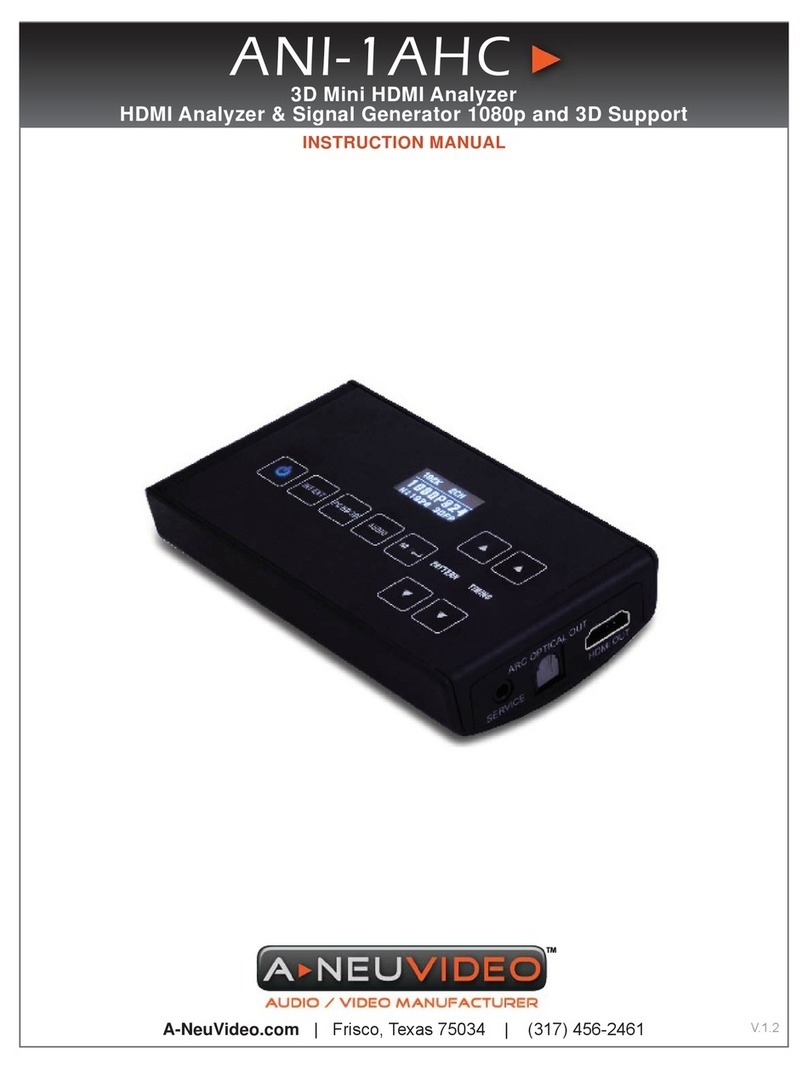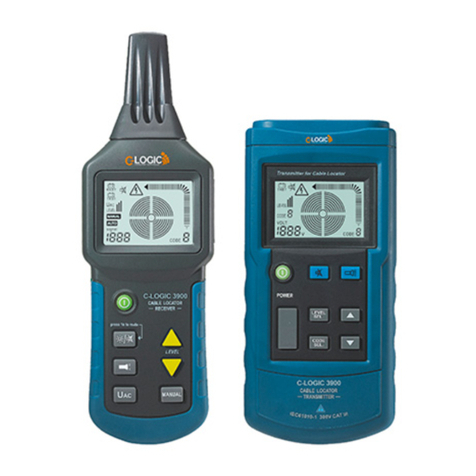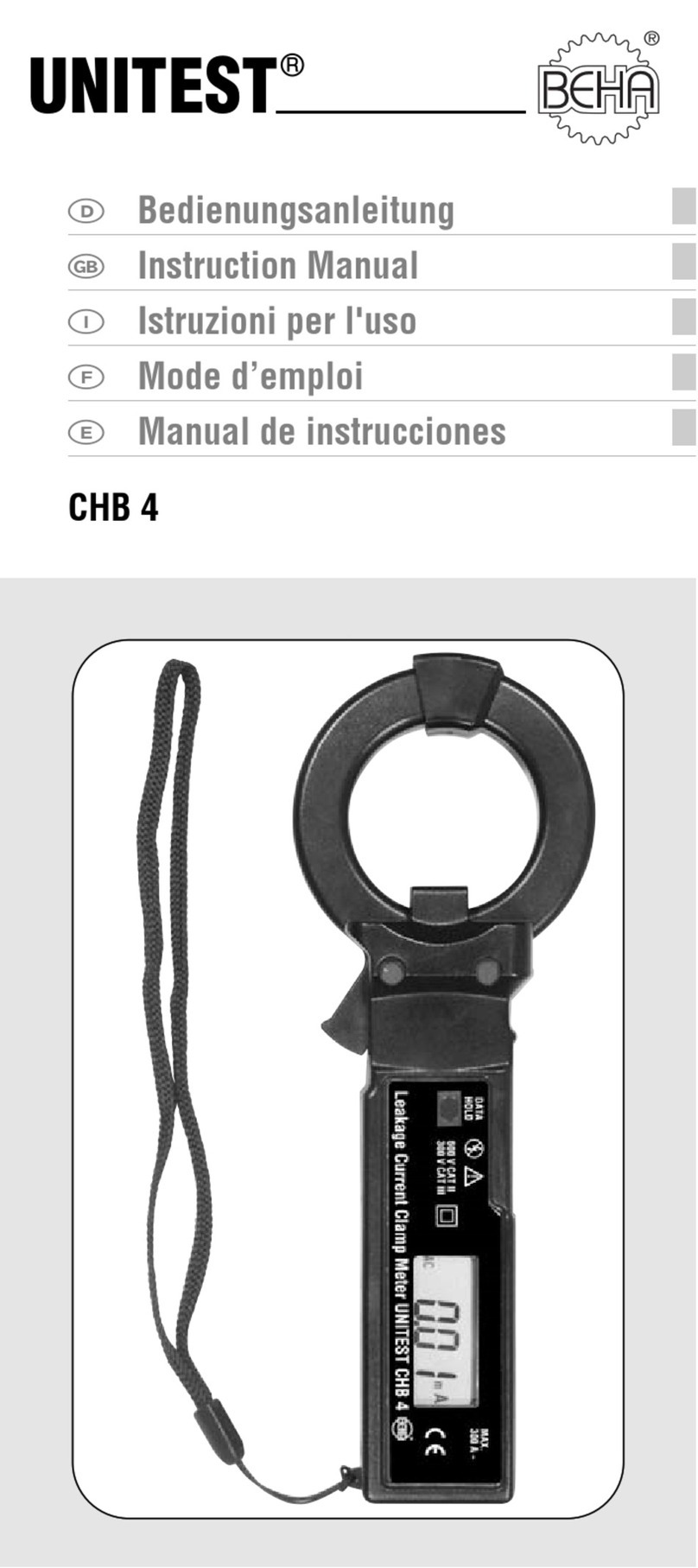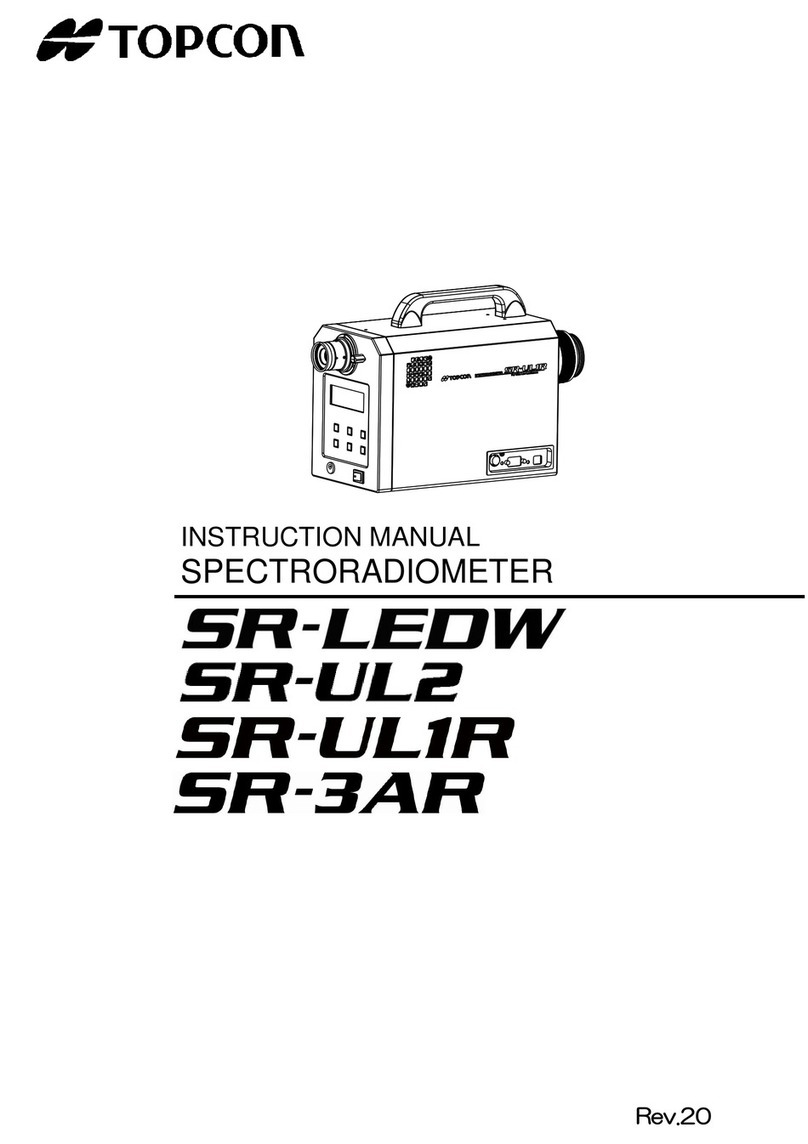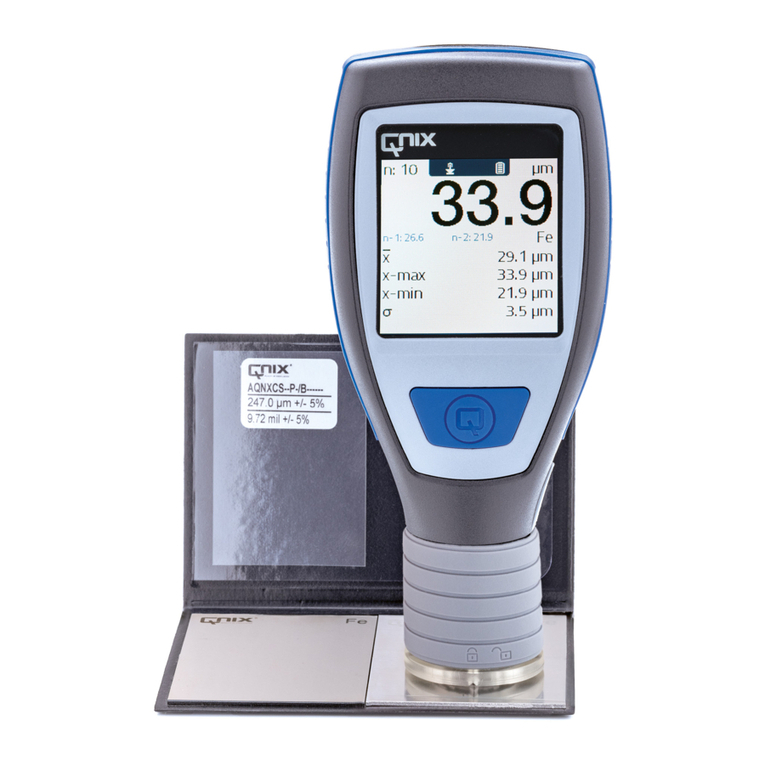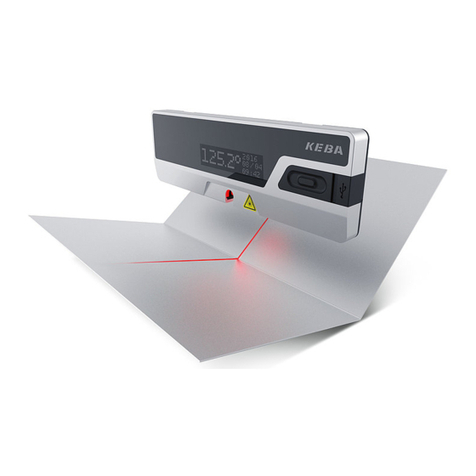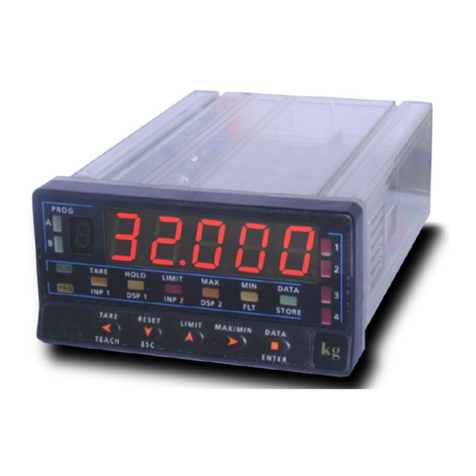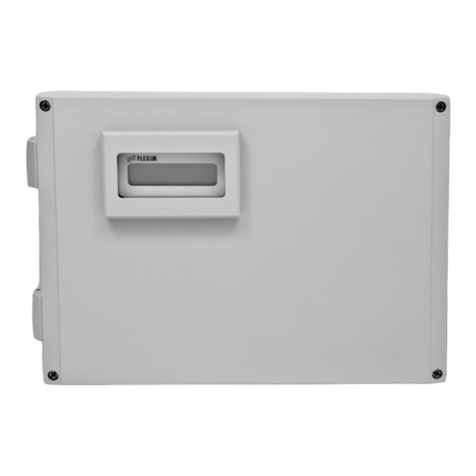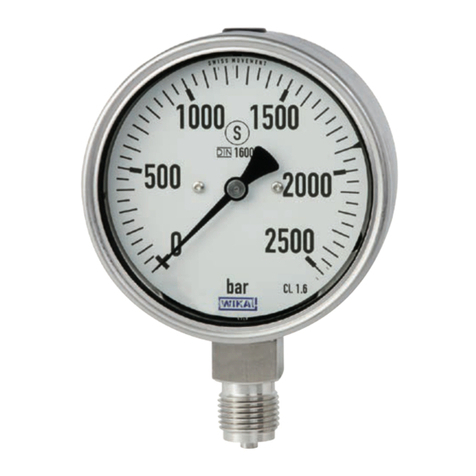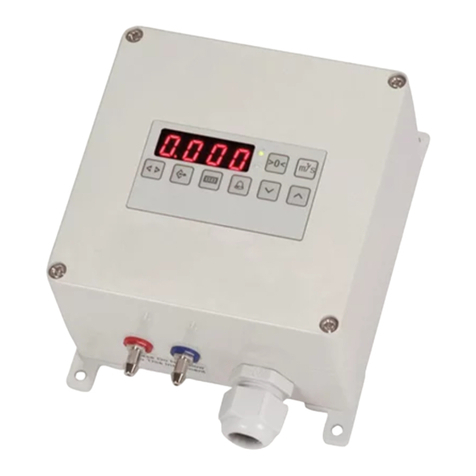A-Neuvideo ANI-4KANA User manual

AUDIO / VIDEO MANUFACTURER
ANI-4KANA
4K UHD+ HDMI Signal Generator & Analyzer
A-NeuVideo.com
Frisco, Texas 75036
INSTRUCTION MANUAL

SAFETY INFORMATION
1. To ensure the best results from this product, please read this manual and all other documentation before operating your
equipment. Retain all documentation for future reference.
2. Follow all instructions printed on unit chassis for proper operation.
3. To reduce the risk of re, do not spill water or other liquids into or on the unit, or operate the unit while standing in liquid.
4. Make sure power outlets conform to the power requirements listed on the back of the unit. Keep unit protected from rain,
water and excessive moisture.
5. Do not attempt to clean the unit with chemical solvents or aerosol cleaners, as this may damage the unit. Dust with a clean
dry cloth.
6. Do not use the unit if the electrical power cord is frayed or broken. The power supply cords should be routed so that they
are not likely to be walked on or pinched by items placed upon or against them, paying particular attention to cords and
plugs, convenience receptacles, and the point where they exit from the appliance.
7. Do not force switched or external connections in any way. They should all connect easily, without needing to be forced.
8. Always operate the unit with the AC ground wire connected to the electrical system ground. Precautions should be taken
so that the means of grounding of a piece of equipment is not defeated.
9. AC voltage must be correct and the same as that printed on the rear of the unit. Damage caused by connection to improper
AC voltage is not covered by any warranty.
10. Turn power off and disconnect unit from AC current before making connections.
11. Never hold a power switch in the “ON” position.
12. This unit should be installed in a cool dry place, away from sources of excessive heat, vibration, dust, moisture and cold.
Do not use the unit near stoves, heat registers, radiators, or other heat producing devices.
13. Do not block fan intake or exhaust ports. Do not operate equipment on a surface or in an environment which may
impede the normal ow of air around the unit, such as a bed, rug, carpet, or completely enclosed rack. If the unit is used
in an extremely dusty or smoky environment, the unit should be periodically “blown free” of foreign dust and matter.
14. To reduce the risk of electric shock, do not remove the cover. There are no user serviceable parts inside. Refer all
servicing to qualied service personnel. There are no user serviceable parts inside.
15. When moving the unit, disconnect input ports rst, then remove the power cable; nally, disconnect the interconnecting
cables to other devices.
16. Do not drive the inputs with a signal level greater than that required to drive equipment to full output.
17. The equipment power cord should be unplugged from the outlet when left unused for a long period of time.
18. Save the carton and packing material even if the equipment has arrived in good condition. Should you ever need to ship
the unit, use only the original factory packing.
19. Service Information Equipment should be serviced by qualied service personnel when:
A. The power supply cord or the plug has been damaged.
B. Objects have fallen, or liquid has been spilled into the equipment.
C. The equipment has been exposed to rain.
D. The equipment does not appear to operate normally, or exhibits a marked change in performance.
E. The equipment has been dropped, or the enclosure damaged.
THIS SAFETY INFORMATION IS OF A GENERAL NATURE AND MAY BE SUPERSEDED BY IN-
STRUCTIONS CONTAINED WITHIN THIS MANUAL.

ANEUVIDEO
1
SAFETY PRECAUTIONS
Please read all instructions before attempting to unpack, install or operate this equipment and before connecting the power
supply. Please keep the following in mind as you unpack and install this equipment:
• Always follow basic safety precautions to reduce the risk of re, electrical shock and injury to persons.
• To prevent re or shock hazard, do not expose the unit to rain, moisture or install this product near water.
• Never spill liquid of any kind on or into this product.
• Never push an object of any kind into this product through any
openings or empty slots in the unit, as you may damage parts inside the unit.
• Do not attach the power supply cabling to building surfaces.
• Use only the supplied power supply unit (PSU). Do not use the PSU if it is damaged.
• Do not allow anything to rest on the power cabling or allow any weight to be placed upon it or any person walk on it.
• To protect the unit from overheating, do not block any vents or openings in the unit housing that provide ventilation and allow
for sufcient space for air to circulate around the unit.
DISCLAIMERS
The information in this manual has been carefully checked and is believed to be accurate. We assume no responsibility for
any infringements of patents or other rights of third parties which may result from its use.
We assume no responsibility for any inaccuracies that may be contained in this document. We make no commitment to update
or to keep current the information contained in this document.
We reserve the right to make improvements to this document and/or product at any time and without notice.
COPYRIGHT NOTICE
No part of this document may be reproduced, transmitted, transcribed, stored in a retrieval system, or any of its part translated
into any language or computer le, in any form or by any means — electronic, mechanical, magnetic, optical, chemical,
manual, or otherwise — without the express written permission and consent.
© Copyright 2021. All Rights Reserved.
Version 2.0 APR 2021
TRADEMARK ACKNOWLEDGMENTS
All products or service names mentioned in this document may be trademarks of the companies with which they are associated.

ANEUVIDEO
2
TABLE OF CONTENTS
INTRODUCTION / PACKAGE CONTENTS.......................................................................................2
FEATURES / SYSTEM REQUIREMENTS / APPLICATIONS............................................................3
SPECIFICATIONS .............................................................................................................................4
OPERATION CONTROLS & FUNCTIONS......................................................................................5
REMOTE CONTROL.........................................................................................................................9
TELNET CONTROL.........................................................................................................................11
RS-232 PINOUT & DEFAULTS / SERIAL & TELNET COMMANDS.........................................12
OSD MENU......................................................................................................................................22
TEST PATTERNS............................................................................................................................67
CONNECTION DIAGRAM...............................................................................................................79
ANAPAT SOFTWARE......................................................................................................................80
VIDEO SPECIFICATIONS...............................................................................................................91
AUDIO SPECIFICATIONS...............................................................................................................95
CABLE SPECIFICATIONS...............................................................................................................96
INTRODUCTION
The ANI-4KANA HDMI Signal Generator & Analyzer is an advanced and handy tool for generating,
testing and verifying the signal path within your 18Gbps HDMI ecosystem. With (87) built-in
resolutions, (56) test patterns and over a dozen types of A/V analysis functions, this unit provides an
enormous range of testing options. HDMI data packet, EDID and HDCP analysis is supported along
with EDID upload and emulation.
Additionally the Status and Control Data Channel (SCDC) can be monitored, allowing HDMI 18Gbps
signal detection and analysis. Up to (8) channels of LPCM audio test tones can be generated with
a wide range of frequencies. This unit also supports the ability to upload up to (2) user-generated
graphic les which can be used as additional test patterns. The use of multi-function and multi-color
backlit buttons allows for easy operation of the unit’s wide variety of functions and a clear OLED
display provides a way to quickly view the current signal status information. In addition to the front
panel buttons, the unit can also be controlled via RS-232, Telnet, and IR providing a complete range
of control options. This unit comes with a 3 year warranty.
PACKAGE CONTENTS
Before attempting to use this unit, please check the packaging and make sure the following items
are contained in the shipping carton:
• HDMI Signal Generator & Analyzer
• Remote Control (ANI-174)
• DC to USB Type-A Power Cable
• Users Guide
• 5V/2.6A Power Adaptor

FEATURES / SYSTEM REQUIREMENTS / APPLICATIONS
FEATURES
• HDMI 2.0 (up to 4K@60Hz 4:4:4) and DVI 1.0 compliant
• HDCP 1.4 and 2.2 compliant
• Analysis of source and sink data paths up to 18Gbps HDMI signals
• Generates HDMI timings up to 18Gbps (4096x2160@60Hz 4:4:4, 8-bit) and VGA timings up to
165MHz (WUXGA, 1920x1200@60Hz RB)
• Sources can be scaled in Analyzer mode to support a wider range of displays when analyzing
potentially incompatible sources
• (59) selectable test patterns in Pattern mode
• Analysis of HDMI data packets, including SCDC
• Analysis and control of HDCP v1.4 and v2.2
• Analysis and emulation of EDID data
• Analysis of input audio signals
• HDR emulation, bypass, and analysis support
• HDR analysis supports HDR10, HLG, and Dolby Vision
• (2) custom user test pattern resolutions: 640x480 & 1920x1080
• External stereo audio input and output
• Generation of LPCM sinewave audio on up to 8 channels
• Small and portable unit with OLED display with rapid updates of current status information
• Firmware update support via USB
• Supports optional Windows control software
• Control via front-panel buttons with detailed OSD/OLED, RS-232, Telnet, and IR remote
SYSTEM REQUIREMENTS
• HDMI/VGA receiving equipment such as an HDTV, monitor or audio amplier and/or HDMI source
equipment such as a media player, video game console or set-top box.
• Analog audio source equipment such as a PC or media player and/or analog audio receiving
equipment such as headphones, an audio amplier or powered speakers.
APPLICATIONS
• Installer/Integrator multi-function test tool
• HDMI source and sink testing
• UHD system/SCDC error identication
• Third-party equipment setup
• Source and sink EDID reading, writing and saving
• HDCP compliance verication
• Production testing
• R&D design and testing
3

SPECIFICATIONS
• HDMI Bandwidth: 18Gbps
• VGA Bandwidth: 165MHz
• Input Ports:
• HDMI (Type-A)
• Stereo Audio (3.5mm)
• Output Ports 1xHDMI (Type-A)
• VGA (HD-15)
• Stereo Audio (3.5mm)
• Control Ports:
• RS-232 (DE-9)
• IP Control (RJ-45)
• Service Port: USB 2.0 (Type-A)
• IR Frequency: 38kHz
• Baud Rate: 115200
• Power Supply: 5V/2.6A DC
• ESD Protection: Human Body Model:
• ±8kV (air-gap discharge)
• ±4kV (contact discharge)
• Dimensions (WxHxD): 4.9 x 1.2 x 6.4 in (125x30x162mm) / 4.7 x 1.2 x 6.1 in (120x30x155mm)
(Case Only)
• Weight: 1.75 lb/796g
• Chassis Material: Metal (Steel)
• Color: Black
• Operating Temperature: 0˚C~40˚C/32˚F~104˚F
• Storage Temperature: −20˚C~60˚C/−4˚F~140˚F
• Relative Humidity: 20~90% RH (non-condensing)
• Power Consumption: 8.4W
As product improvements are continuous, specications are subject to change without notice.
4

OPERATION CONTROLS & FUNCTIONS
TOP PANEL
qOLED SCREEN: Displays the current signal analysis information or test pattern mode selection
details including input and/or output resolution timing. The screen layout changes depending on the
unit’s mode.
ANALYZER MODE (Analyzer/Pattern button is RED): In
Analyzer mode, if there is no live video source detected on the
input port, the OLED will display any voltage, TMDS or sync that
might be present.
Once a live video signal is detected, the unit will display that
signal’s current timing, format, HDCP version, AV Mute status,
color space, color depth and audio format.
PATTERN MODE (ANALYZER/PATTERN BUTTON IS BLUE):
In Pattern mode, when the output isn’t connected to a sink, the
unit will display the current output timing, RxSense, and Hot-
plug detection status.
Once an active sink has been connected, the lower portion
of the display will change to indicate the current test pattern
number and name.
wIR WINDOW: Accepts IR signals from the included IR remote for control of this unit only.
eMENU: Press to enter the OSD menu or to back out from menu items.
5

6
OPERATION CONTROLS & FUNCTIONS
rENTER/OPTION: Press to conrm a selection or to go deeper into a menu item. When the
selected function has optional selections, the associated button’s LED will illuminate along with the
▼/▲ (-/+) buttons.
t+/- & ▲/▼: Press to move up and down or adjust selections within menus. These buttons will
illuminate when the selected function has values that can be adjusted up or down.
yPATTERN: Within Pattern mode, press to enable selection of the test pattern used. The ▼/▲
buttons will illuminate and are used to select the new pattern. The new test pattern will automatically
become active after selecting it and pausing for 2 seconds. Additional variations (if available) are
selected by pressing the PATTERN button additional times.
TITLE-SAFE OVERLAY: Within Analyzer mode, press to cycle through a variety of “title-safe/
action-safe” overlays.
NOTE: This feature is not available when the output resolution is set to bypass mode.
uTIMING: Press to enable selection of the output timing and resolution used. The ▼/▲ buttons
will illuminate and are used to select the new timing. The currently selected timing will be shown on
the OLED display. The new timing will automatically become active after selecting it and pausing for
2 seconds.
FORCE BYPASS: In Analyzer mode, press and hold this button for 2 seconds to force the output to
use Bypass mode.
NOTE: In Analyzer mode, please select the “Bypass” timing if you do not wish for your source’s
output signal to be scaled by the unit before being sent to the display. The TIMING button’s LED will
blink red when the timing is set to Bypass.
iANALYZER/PATTERN: Press to switch the unit between Analyzer Mode (LED=Red) and Pattern
Mode (LED=Blue).
FORCE HOT-PLUG: When in Analyzer Mode, press and hold the button for 2 seconds to force a
hot-plug on the HDMI input.
AV MUTE: When in Pattern Mode, press and hold the button for 2 seconds to turn on/off the AVMute
bit within the output’s GCP (General Control Packet).
FACTORY RESET: Press and hold this button while powering the unit on to perform a factory reset
of the unit.
oEDID PATTERN: Press to enable selection of the EDID to use on the HDMI input port. The ▼/▲
buttons will illuminate and are used to select the new EDID. The currently selected EDID will be
shown on the OLED display. The new EDID will automatically become active after selecting it and
pausing for 5 seconds.

7
OPERATION CONTROLS & FUNCTIONS
aAUDIO LPCM: Within Analyzer mode, press to select which Serial Data audio source pair
(SD0~SD3) is routed to the primary stereo channel (LPCM 2.0 and headphone output) for monitoring.
The LED color indicates the selection (Off=SD0, Red=SD1, Blue=SD2, Purple=SD3). Within Pattern
mode, press to switch between LPCM 2.0 (LED=Red), 5.1 (LED=Blue) and 7.1 (LED=Purple)
channel test tone output formats.
VOLUME CONTROL: Press and hold this button for 2 seconds to allow adjustment of the output
volume by using the + / ▲ & − / ▼ buttons.
sHDCP PATTERN: Press to enable/disable the OSD display of the detected HDCP version support
and handshaking information between the sink and source. In Analyzer mode the unit is the Rx,
in Pattern mode the unit is the Tx. In Pattern mode, if HDCP handshaking fails, an error message
“HDCP OUT FAIL” will be displayed on the OSD.
dHDCP ON/OFF: Press to switch between supported HDCP versions or to disable HDCP. Within
Analyzer mode, OFF (LED=Off), HDCP 1.4 (LED=Red), and HDCP 1.4+2.2 (LED=Blue) modes are
available for the input port. Within Pattern mode, OFF, HDCP 1.4, and HDCP 2.2 modes are available
for the output port.
fCOLOR SPACE: Press repeatedly to switch between the available color space formats.
The button’s LED is colored to indicate the current color space: Red=RGB, Blue=YCbCr 4:4:4,
Purple=YCbCr 4:2:0, Off=YCbCr 4:2:2.
NOTE: This control is not valid when the output resolution is set to bypass mode.
gDEEP COLOR: Press repeatedly to switch between the available output color bit depth options.
The button’s LED is colored to indicate the current bit depth: Off=8-bit, Red=10-bit, Blue=12-bit.
NOTE: This control is not valid when the output resolution is set to bypass mode.
hOUTPUT FORMAT: Press to switch between DVI (LED=Blue) and HDMI (LED=Red) output
formats.
DISABLE OUTPUT: Press and hold the button for 2 seconds to disable/ enable video output
completely. The button’s LED will turn off when output is disabled.
NOTE: This control is not valid when the output resolution is set to bypass mode.

OPERATION CONTROLS & FUNCTIONS
SIDE Panels
qAUDIO OUT: Connect to powered speakers or an amplier for stereo analog audio output with a
3.5mm phone jack cable.
wVGA OUT PORT: Connect to a VGA (RGBHV) monitor or display for analog video output.
NOTE: Only supports RGBHV output (YUV, RGBS, and RGsB are not supported). In Analyzer mode
the VGA output is disabled. OSD Menu display is not supported.
eHDMI OUT PORT: Connect to an HDMI TV, monitor or amplier for digital video and audio output.
rHDMI IN PORT: Connect to HDMI source equipment such as a media player, game console or
set-top box.
tAUDIO IN PORT: Connect to the stereo analog output of a device such as a CD player or PC.
qPOWER SWITCH: Flip this switch to turn the unit ON or OFF after connecting an appropriate
power source.
wCONTROL PORT: Connect directly, or through a network switch, to your PC/laptop to control the
unit via Telnet.
eRS-232 PORT: Connect directly to your PC/laptop to send RS-232 commands to control the unit.
rCONTROL: This slot is used for rmware updates and uploading customer designed test pattern
les.
NOTE: Test patterns are restricted to 640x480 and 1920x1080. Only *.bmp 24-bit RGB bitmap les
are supported.
tDC 5V PORT: Plug the 5V DC power supply into the unit and connect it to an AC wall outlet for
power or use the DC to USB adapter cable to connect to a portable USB power bank (2.1A minimum)
for power.
8

9
REMOTE CONTROL
The IR remote uses one out of (4) available address channels
for control of the test pattern generator, allowing up to (4) to
be located in the same area while being controlled by different
remotes.
To congure this, select “IR Controller Address” within the
“Setup” section of the OSD’s main menu.
Assign an address number (from 0 to 3) that matches the setting
on the remote that is to be used with the unit.
The IR remote’s address can be set using the (2) DIP switches
located on the back of the remote, inside the battery cover. The
default factory setting is 0 (off, off).
qANALYZER/PATTERN: Press to switch between Analyzer
Mode and Pattern Mode.
wEDID: Press repeatedly to switch between the available EDIDs for the HDMI input.
eCOLOR SPACE: Press repeatedly to switch between the available color space formats (RGB,
YCbCr 4:4:4, YCbCr 4:2:2 & YCbCr 4:2:0).
rHDCP SW.: Press to switch between supported HDCP versions or to disable HDCP.
tFORMAT: Press to switch between DVI and HDMI output formats.
yVGA~4K6G: Press to directly select the output resolution.
uOUTPUT ON: Press to enable video output.
iOUTPUT OFF: Press to disable video output.
oT-/T+: Press ◄ / ► to select a new output resolution timing. Within the OSD menu, press to
adjust selections.
P+/P-: Press ▲/ ▼ to change the current test pattern. Within the OSD menu, press to move up
and down.
OK: After selecting a pattern, press and hold for 2 seconds to switch to alternate variations of the
pattern. Within the OSD menu, press to conrm selections.

REMOTE CONTROL
aMENU: Press to enter the OSD menu.
sEXIT: Press to exit the OSD or cancel the selection.
dFOR USE IN ANALYZER MODE ONLY:
SOURCE: Press to display source signal information on the OSD.
VIDEO T: Press to display video analysis details on the OSD.
AUDIO T: Press to display audio analysis details on the OSD.
PACKET: Press to display the HDMI input’s packet analysis info.
HOTPLUG: Press to force an RX hot-plug event on the input port.
FOR USE IN PATTERN MODE ONLY:
SINK: Press to display HDMI output detection/information on the OSD.
AV MUTE1: Press to turn on the AVMute bit within the output’s GCP.
AV MUTE0: Press to turn off the AVMute bit within the output’s GCP.
f AUDIO CH: Within Analyzer mode, press to select which Serial Data audio source pair (SD0–
SD3) is routed to the primary stereo channel for monitoring. Within Pattern mode, press to switch
between LPCM 2.0, 5.1 & 7.1 channel test tone output formats.
g MUTE/VOL-/VOL+: Press the Mute button to mute both digital and analog audio outputs. Press
the Vol+/Vol− buttons to increase/decrease the volume.
10

Telnet Control
Before attempting to use Telnet control, please ensure that both the unit and the PC are connected
to the same active networks.
Start your preferred Telnet/Console client, or use the built in client provided by most modern computer
operating systems. After starting the client, connect by using the current IP address of the unit and
port 23 (if the communication port number used by the unit has not been changed previously). This
will connect us to the unit we wish to control and commands may now be entered directly.
NOTE 1: If the IP address of the unit is changed then the IP address required for Telnet access will
also change accordingly.
NOTE 2: The default IP address is 192.168.1.50 and the default communication port is 23.
To Access Telnet
Windows 7 Click START, type “cmd” in the search eld and press ENTER.
Windows 10 1. Open “Control Panel”.
2. Open “Programs and Features”.
3. Select the “Turn Windows features on or off ” option.
4. Check the “Telnet Client” box.
5. Click “OK“. A box will appear that says “Windows Features” and
“Searching for required les”. When complete, the Telnet client should be
installed in Windows.
In Mac OS X Click Go > Applications > Utilities > Terminal.
Once in the Command Line Interface (CLI), type “telnet” followed by the current IP address of the
unit and “23”, then hit ENTER. See below for reference.
This will connect us to the unit we wish to control. Type “help” to list the available commands.
11

12
RS-232 Pinout & Defaults / Serial & Telnet Commands
RS-232 Protocol
SERIAL PORT DEFAULT SETTINGS
Baud Rate: 115200bps
Data Bits: 8
Parity: None
Flow Control: None
Stop Bit: 1
Serial & Telnet Commands
Before using the commands, please read the following:
SYNTAX
All commands MUST start with the “$” character or the command will not be recognized by the unit.
Commands must end with a carriage return (0x0D). Use of a line feed (0x0A) is optional. Commands
are not case-sensitive.
PARAMETERS
The characters “[“ and “]” are placed around descriptions of the variable parameters where
additional explanation was needed. Please type the selected parameter without the contents inside
the “[“ and “]” characters when entering the command.
RESPONSES
The unit will respond to most commands with a repeat of the original command followed by the
specied parameters or requested information except where otherwise noted. If an invalid command
is entered the unit will respond with “$err”. All unit responses end with a carriage return (0x0D) +
line feed (0x0A).
CAUTIONS
Only one command may be processed at a time. Additional commands should not be sent until the
response from the previous command has been received.

Serial & Telnet Commands
COMMAND DESCRIPTION
$? Show full command list.
$HELP Show full command list.
$AUDIO_CH N1 Set the number of internally sourced audio output channels.
Available values for N1:
2 [2 Channels (2.0)]
6 [6 Channels (5.1)]
8 [8 Channels (7.1)]
$AUDIO_CH? Show the current number of audio output channels.
$AUDIO_FREQ N1,N2
Set the internal audio output frequency of the selected channel (in Hz).
Available Values for N1:
SD0_L [SD0 Left Channel] SD0_R [SD0 Right Channel]
SD1_L [SD1 Left Channel] SD1_R [SD1 Right Channel]
SD2_L [SD2 Left Channel] SD2_R [SD2 Right Channel]
SD3_L [SD3 Left Channel] SD3_R [SD3 Right Channel]
Available Values for N2:
MUTE [No audio] 600 [600 Hz] 1200 [1200 Hz]
200 [200 Hz] 800 [800 Hz] 1400 [1400 Hz]
400 [400 Hz] 1000 [1000 Hz] 1600 [1600 Hz]
$AUDIO_FREQ? N1 Show the internal audio output frequency of the selected channel (in Hz).
Available Values for N1:
SD0_L [SD0 Left Channel] SD0_R [SD0 Right Channel]
SD1_L [SD1 Left Channel] SD1_R [SD1 Right Channel]
SD2_L [SD2 Left Channel] SD2_R [SD2 Right Channel]
SD3_L [SD3 Left Channel] SD3_R [SD3 Right Channel]
$AUDIO_MUTE N1 Enable or disable muting the audio output.
Available values for N1:
ON [Mute enabled] OFF [Mute disabled]
$AUDIO_MUTE? Show the current audio output mute state.
$AUDIO_SOURCE N1 Set the audio output source.
Available values for N1:
ANA [Analog Input] HDMI [HDMI Input] INT [Internal]
$AUDIO_SOURCE? Show the current audio output source.
$AUDIO_SR N1 Set the internal audio output sampling rate (in kHz).
Available values for N1:
48 [48 kHz] 96 [96 kHz] 192 [192 kHz]
$AUDIO_SR? Show the current internal audio output sampling rate.
$AUDIO_VOL N1 Set the audio output volume.
N1 = 0~80 [Volume level]
13

Serial & Telnet Commands
COMMAND DESCRIPTION
$AUDIO_VOL? Show the current audio output volume.
$BOOT GO Reboot the unit.
NOTE: The unit won’t respond to any commands during the boot
process.
$BOOT? Show the current boot state.
$COLOR_SPACE N1 Set the output color space.
Available values for N1:
RGB [RGB 4:4:4] Y444 [YCbCr 4:4:4]
Y422 [YCbCr 4:2:2] Y420 [YCbCr 4:2:0]
$COLOR_SPACE? Show the current output color space.
$DEEP_COLOR N1
Set the output color bit depth.
Available values for N1:
8 [8 bits] 10 [10 bits] 12 [12 bits]
$DEEP_COLOR? Show the current output color bit depth.
$EDID_COPY_SINK
N1
Copy the current HDMI sink’s EDID to the designated copy slot.
N1 = C1~C10 [Copy EDID number]
NOTE: If the copy fails “$err” will be displayed.
$EDID_MANUF? N1 Show the manufacturer name stored in the EDID of the selected
location.
Available values for N1:
RX [HDMI Input (Rx) Port]
SINK_H [HDMI Sink] SINK_V [VGA Sink]
NOTE: If the EDID fails to be read, “$err_ddc” will be displayed. If the
EDID has invalid content, “$err_bad” will be displayed.
$EDID_MODEL? N1 Show the model/monitor name stored in the EDID of the selected
location.
Available values for N1:
RX [HDMI Input (Rx) Port]
SINK_H [HDMI Sink] SINK_V [VGA Sink]
NOTE: If the EDID fails to be read, “$err_ddc” will be displayed. If the
EDID has invalid content, “$err_bad” will be displayed.
$EDID_NAME N1,N2 Set the EDID name of the selected copy slot.
N1 = C1~C10 [Copy EDID number]
N2 = {Name} [20 characters max]
$EDID_NAME? N1 Show the name of the selected EDID slot.
Available values for N1:
D1~D10 [Default EDID number]
C1~C10 [Copy EDID number]
14

Serial & Telnet Commands
COMMAND DESCRIPTION
$EDID_NATIVE? N1 Show the native resolution value stored in the EDID of the selected location.
Available values for N1:
RX [HDMI Input (Rx) Port]
SINK_H [HDMI Sink] SINK_V [VGA Sink]
NOTE: First detailed timing from Block 0. If the EDID fails to be read,
“$err_ddc” will be displayed. If the EDID has invalid content, “$err_
bad” will be displayed.
$EDID_READ N1,N2 Shows the selected data block stored in the EDID of the selected location.
Available values for N1:
D1~D10 [Default EDID 1~10] C1~C10 [Copy EDID 1~10]
SINK_H [HDMI Sink] SINK_V [VGA Sink]
Available values for N2:
BLOCK0 [EDID Block 0] BLOCK1 [EDID Block 1]
BLOCK2 [EDID Block 2] BLOCK3 [EDID Block 3]
NOTE: This data is output as a bit stream of 128 bytes following the
<CR><LF> of the command acknowledgement. Each hex data unit is
composed of 3 digits. The rst 2 digits are the hex value. The 3rd digit
is a space (0x20). Blocks 2 & 3 are only supported from the HDMI Sink.
$EDID_RX N1 Select the EDID to use with the unit’s HDMI input (Rx).
Available values for N1:
D1~D10 [Default EDID 1~10] C1~C10 [Copy EDID 1~10]
SINK [Currently connected HDMI sink]
$EDID_RX? Show the current EDID selection for the unit’s HDMI input (Rx).
$EDID_TYPE? N1 Show the current EDID type of the selected location.
Available values for N1:
RX [HDMI Input (Rx) Port]
SINK_H [HDMI Sink] SINK_V [VGA Sink]
NOTE: If the EDID fails to be read, “$err_ddc” will be displayed. If the
EDID has invalid content, “$err_bad” will be displayed.
$EDID_WRITE N1,N2
N3
Directly write an EDID block to the selected EDID location.
Available values for N1:
RX [HDMI Input (Rx) Port]
SINK_H [HDMI Sink] SINK_V [VGA Sink]
N2 = BLOCK0~BLOCK1 [EDID block to write to]
N3 = <CR><LF>{Data} [128 byte hex data]
NOTE: The data must be sent as a 128 byte hex data bit stream
following the <CR><LF> in the N3 part of the command. Each hex
data unit is composed of 3 digits. The rst 2 digits are the hex value.
The 3rd digit is a space (0x20). If the sum of the 128 byte data isn’t 0,
“$err_checksum” will be displayed.
15

Serial & Telnet Commands
COMMAND DESCRIPTION
$FACTORY Execute a factory reset and reboot the unit.
NOTE: Stored Copy EDIDs and Ethernet settings will not be reset.
$FWVER? Show the current rmware version.
$HDCP_IN_SW N1 Enable or disable HDCP support for the unit’s HDMI input.
Available values for N1:
ON [Enable HDCP] OFF [Disable HDCP]
NOTE: Affects Analyzer mode only.
$HDCP_IN_SW? Show the current HDCP support setting for the unit’s HDMI input.
$HDCP_IN_VER N1 Set the HDCP version to use on the unit’s HDMI input.
Available values for N1:
V1.4 [HDCP v1.4 only] V1.4+V2.2 [HDCP v1.4 & v2.2]
NOTE: Affects Analyzer mode only.
$HDCP_IN_VER? Show the current HDCP version used on the unit’s HDMI input.
$HDCP_OUT_SW N1 Enable or disable HDCP support on the unit’s HDMI output.
Available values for N1:
ON [Enable HDCP] OFF [Disable HDCP]
NOTE: Affects Pattern mode only.
$HDCP_OUT_SW? Show the HDMI output’s current HDCP status.
NOTE: A status of “Talk” means HDCP is currently performing
handshaking.
$HDCP_OUT_VER
N1
Set the HDCP version to use on the unit’s HDMI output.
Available values for N1:
V1.4 [HDCP v1.4] V2.2 [HDCP v2.2]
NOTE: Affects Pattern mode only.
$HDCP_OUT_VER? Show the current HDCP version used by the output port.
$HDR_EOTF N1 Set the HDR EOTF (Electro-Optical Transfer Function) mode.
Available values for N1:
SDR [Traditional gamma, SDR lum. range]
HDR [Traditional gamma, HDR lum. range]
2084 [SMPTE ST 2084]
RSVD [Reserved for future use]
$HDR_EOTF? Show the current HDR EOTF mode.
$HDR_MCLL N1 Set the maximum HDR content light level.
N1 = 0~65500 [Incremented in 100 unit steps]
$HDR_MCLL? Show the current maximum HDR content light level.
$HDR_MFALL N1 Set the maximum HDR frame-average light level.
N1 = 0~65500 [Incremented in 100 unit steps]
16

Serial & Telnet Commands
COMMAND DESCRIPTION
$HDR_MFALL? Show the current maximum HDR frame-average light level value.
$HDR_SET N1 Select the current HDR preset group.
N1 = 1~3 [HDR preset group]
$HDR_SET? Show the currently selected HDR preset group.
$HDR_SW N1 Enable or disable HDR support on the unit’s HDMI output.
Available values for N1:
ON [Enable HDR] OFF [Disable HDR]
$HDR_SW? Show the current HDR support status for the unit’s HDMI output.
$HDR_TX_COL N1 Set the HDMI output (Tx) AVI Colorimetry mode.
Available values for N1:
1 [No Data] 6 [sYCC601]
2 [ITU601] 7 [AdobeY601]
3 [ITU709] 8 [Adobe RGB]
4 [xvYCC601] 9 [BT.2020(1) Y’CC’BCC’RC]
5 [xvYCC709] 10 [BT.2020(2) R’G’B’ or Y’C’BC’R]
$HDR_TX_COL? Show the current HDMI output (Tx) AVI Colorimetry mode.
$MODEL? Show the unit’s model name.
$MOTION_TEXT N1 Set the text used for the Motion-H and Motion-V patterns.
N1 = {ASCII text} [20 characters max]
$MOTION_TEXT? Show the current text used for the Motion-H and Motion-V patterns.
$NET_GATE? Show the unit’s current gateway address.
$NET_IP? Show the unit’s current IP address.
$NET_IP_MODE N1 Set the unit’s IP address assignment mode.
Available values for N1:
DHCP [DHCP mode] STATIC [Static IP address mode]
$NET_IP_MODE? Show the current IP address assignment mode.
$NET_LINK? Show the unit’s current Ethernet link status.
$NET_MAC? Show the unit’s MAC address.
$NET_MASK? Show the unit’s current netmask address.
$NET_STATIC_GATE
N1
Set the unit’s static gateway address.
N1 = X.X.X.X [X = 0~255, static gateway address]
$NET_STATIC_GATE? Show the unit’s static gateway address.
$NET_STATIC_IP N1 Set the unit’s static IP address.
N1 = X.X.X.X [X = 0~255, static IP address]
17

Serial & Telnet Commands
COMMAND DESCRIPTION
$NET_STATIC_IP? Show the unit’s static IP address.
$NET_STATIC_MASK
N1
Set the unit’s static netmask address.
N1 = X.X.X.X [X = 0~255, static netmask]
$NET_STATIC_MASK? Show the unit’s static netmask address.
$PATTERN N1 Select the test pattern to output.
N1 = 1~59 [Test pattern number]
$PATTERN? Show the current test pattern selection.
$RX_DDC N1
Enable or disable the DDC bus for the HDMI input (Rx).
Available values for N1:
ON [Enable DDC] OFF [Disable DDC]
$RX_DDC? Show the DDC bus state for the HDMI input (Rx).
$RX_HOTPLUG N1 Set the hot plug value for the HDMI input (Rx).
Available values for N1:
OFF [Set hot plug low] ON [Set hot plug high]
TOGGLE [Toggle hot plug low->high or high->low]
$RX_HOTPLUG? Show the current hot plug state for the HDMI input (Rx).
$RX_HOTPLUG_T N1 Set the hot plug time (in milliseconds) for the HDMI input (Rx).
N1 = 50~500 [Incremented in 50ms steps]
$RX_HOTPLUG_T? Show the current hot plug time (in milliseconds) for the HDMI input (Rx).
$RX_PC_TOL N1 Set PC source clock detection tolerance for the HDMI input (Rx).
N1 = 1~10 [PC clock tolerance]
$RX_PC_TOL? Show the current PC source clock detection tolerance for the HDMI
input (Rx).
$RX_SCDC N1 Enable or disable the SCDC port function on the HDMI input (Rx).
Available values for N1:
ON [Enable SCDC] OFF [Disable SCDC]
$RX_SCDC? Show the current SCDC port state for the HDMI input (Rx).
$RX_SENSE N1 Enable or disable the RxSense function for the HDMI input (Rx).
Available values for N1:
ON [Enable RxSense] OFF [Disable RxSense]
$RX_SENSE? Show the current RxSense state for the HDMI input (Rx).
$SINK_DETECT? N1 Displays a variety of sink detection status and informational values.
Available values for N1:
HOTPLUG [Sink’s hot plug status]
RSENSE [Sink’s RxSense status]
HDCP [Sink’s HDCP port status]
18
Table of contents
Other A-Neuvideo Measuring Instrument manuals

